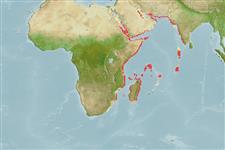>
Mulliformes (Goatfishes) >
Mullidae (Goatfishes)
Etymology: Upeneus: Greek, ypene, -es = upper lip (Ref. 45335); heemstra: Named for Phil and Elaine Heemstra..
Environment: milieu / climate zone / depth range / distribution range
Ecologia
marinhas demersal; intervalo de profundidade 0 - 12 m (Ref. 95469). Tropical
Western Indian Ocean: Mozambique to Central Red Sea, Seychelles, W India and Sri Lanka,
Tamanho / Peso / Idade
Maturity: Lm ? range ? - ? cm
Max length : 15.0 cm SL macho/indeterminado; (Ref. 95469)
Descrição suscinta
Chaves de identificação | Morfologia | Morfometria
Espinhos dorsais (total) : 8; Raios dorsais (total) : 9; Espinhos anais: 1; Raios anais : 6. This species is distinguished by the following characters: D VIII + 9; pectoral-fin rays 12-14; gill rakers 4-8 + 14-18 = 19-24; lateral-line scales 28-30; in %SL: body depth at first dorsal-fin origin 22-26; body depth at anal-fin origin 19-23; caudal-peduncle depth 9.5-11; caudal-peduncle width 2.9-4.6; maximum head depth 19-22; head depth through eye 14-17; head length 27-31; postorbital length 10-13; orbit length 6.3-8.3; upper jaw length 9.8-13; barbel length 15-20; caudal peduncle
length 21-23; caudal-fin length 27-30; anal-fin height 16-19; pelvic-fin length 20-22; pectoral-
fin length 19-21; pectoral-fin width 3.7-4.9; first dorsal-fin height 19-23; second dorsal-fin height 17-18; postorbital length 1.4-1.8 times in anal-fin height; colour of all fins with red, brown or black
stripes, bars or blotches; caudal fin with 9-12 oblique bars, 4-6 bars on upper caudal-fin lobe
and 5-6 bars on lower caudal-fin lobe; first dorsal fin possess a large blotch around tip; one pale- or dark brown mid-lateral body stripe from tip of snout through eye to caudal base; body and head ground colour white or beige, slightly darker above lateral line, with irregular red, brown or black spots and/or blotches; fresh specimens with yellow or pale brown barbels; fin and body pigmentation mostly retained in preserved fish (Ref. 95469).
Found over sand and mud bottoms near coral reefs (Ref. 30573); generally solitary (Ref. 5213). An invertebrate feeder (Ref. 41878).
Ciclo de vida ou comportamento de acasalamento
Maturities | Reprodução | Spawnings | Egg(s) | Fecundities | Larvas
Uiblein, F. and G. Gouws, 2014. A new goatfish species of the genus Upeneus (Mullidae) based on molecular and morphological screening and subsequent taxonomic analysis. Mar. Biol. Res. 10(7):655-681. (Ref. 95469)
Status na Lista Vermelha da UICN (Ref. 130435)
Ameaça para os humanos
Harmless
Uso pelos humanos
Ferramentas
Relatórios especiais
Baixar XML
Fontes da internet
Estimates based on models
Preferred temperature (Ref.
123201): 26.2 - 29.1, mean 27.6 °C (based on 601 cells).
Índice de diversidade filogenética (Ref.
82804): PD
50 = 0.5000 [Uniqueness, from 0.5 = low to 2.0 = high].
Bayesian length-weight: a=0.00851 (0.00440 - 0.01645), b=3.08 (2.92 - 3.24), in cm total length, based on LWR estimates for this species & Genus-body shape (Ref.
93245).
Nível Trófico (Ref.
69278): 3.5 ±0.4 se; based on size and trophs of closest relatives
Resiliência (Ref.
120179): Elevada, tempo mínimo de duplicação da população menor que 15 meses (Preliminary K or Fecundity.).
Fishing Vulnerability (Ref.
59153): Low vulnerability (10 of 100).
